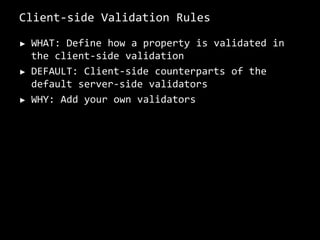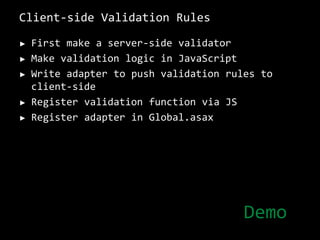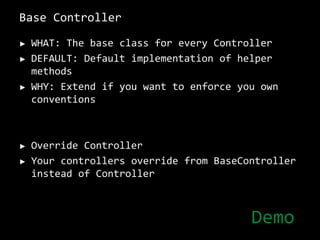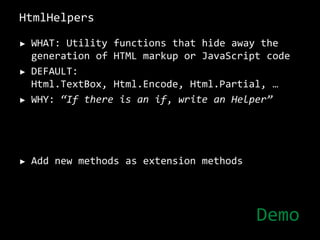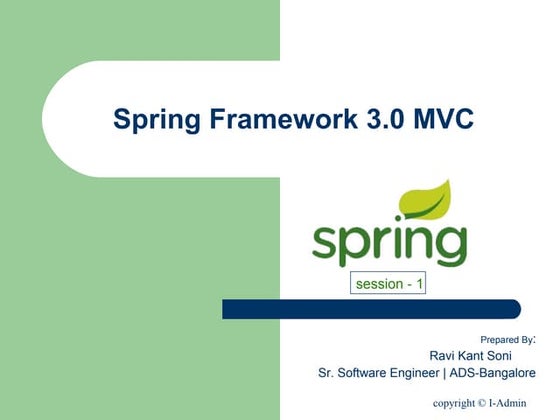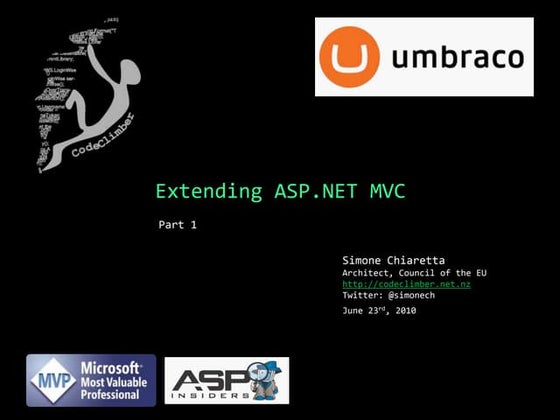Asp.net mvc
- 1. ASP.NET MVC CRUSH COURSEERDEM ERG─░N
- 2. MVC Pattern ŌĆō What is it?MVC - Acronym for Model/View/ControllerInvented by TrygveReenskaug[1973 - 1978]Originally used as an architectural pattern for GUIs.The first implementation of MVC was as part of Smalltalk-80 class library.
- 3. MVC Pattern ŌĆō How does it work?The Controller asks the Model for dataThe request hits the controllerModel213ControllerUserThe Model gives the data back to the ControllerThe controller formats the data and passes them to the ViewView45The view renders the HTML that needs to be sent to the client3
- 4. MVC Pattern ŌĆō Who uses it?.NET has Spring.NET, MonoRailJava has Swing, Struts, Grails and othersPerl has Catalyst, Gantry, Jifty and othersPHP has Zend, Zoop, Agavi and othersPython has Django, Gluon, Pylon and othersRuby has Ruby on RailsApple has cocoa and cocoa touch for objective-c [Mac, iPhone]
- 5. MVC FrameworkHistoryBased on Python1970SŌĆ”.2003 RoR{ ASP.NET MVC }2009.3 MVC1 2010.4 MVC2
- 6. ASP.NET MVCItŌĆÖs not a replacement for asp.net webforms, itŌĆÖs a new option [flavor]
- 7. No more ŌĆ£postbacksŌĆØ and ŌĆ£ViewStatesŌĆØ
- 8. Built on top of ASP.NETAdvantagesClean URLs and HTML
- 9. More control over your html and JavaScript
- 10. Friendly URLS
- 11. More easily Testable Framework.
- 12. All ASP.Net providers still work [Membership, Session, Caching, etc]
- 13. Extensible and Pluggable [Support replacing any component]ASP.NET MVC Framework StructureASP.NET Abstractions(System.Web.Abstractions.dll)ASP.NET Routing(System.Web.Routing.dll)ASP.NET MVC(System.Web.Mvc.dll)
- 14. ASP.NET MVC Execution Process
- 15. DEMOCreate New ASP.NET MVC ProjectInvestigate ASP.NET MVC Structure
- 16. RoutingMVC+RR => the hidden character
- 17. ASP.NET MVC RoutingURL PatternsSetting Default Values for URL ParametersAdding Constraints to RoutesScenarios When Routing Is Not AppliedHow URLs Are Matched to RoutesAccessing URL Parameters in a Routed PageASP.NET Routing and SecurityASP.NET Routing versus URL Rewriting
- 19. Controller [C]Controlling the flow of application execution
- 20. ASP.NET MVC ControllerController is a class consisting of a set of action methods. Responsible for Handling user interactionWorking with the modelsSelecting a view to renderSending model and information to a particular viewMaking decisions for security, UI, redirects ... etc.The ASP.Net MVC requires the names of all controllers to end with the suffix "ControllerŌĆ£ e.g. HomeController, LoginController
- 21. ASP.NET MVC ControllerA controller action always returns an ActionResultWhat if I return an object ??Action return ActionResult which can beViewResult => HTML and markup.
- 23. RedirectResult => redirection to a new URL.
- 24. JsonResult => json result that can be used in an AJAX application.
- 26. ContentResult => text result [and wraps any non ActionResult return Type].
- 27. FileContentResult => downloadable file [with the binary content].
- 28. FilePathResult => downloadable file [with a path].
- 29. FileStreamResult => a downloadable file [with a file stream]. Note: all public methods of a controller class consideredas action methods, if you donŌĆÖt want a public method to be an action, mark it with [NonAction()] attribute
- 30. ASP.NET MVC Controller Filter
- 31. View [V]
- 32. ASP.NET MVC ViewResponsible for presentation, look & feel, formatting, sorting ŌĆ” etc. Interacts with model but shouldnŌĆÖt make decisions No logic should go thereCode Behind exists but not recommendedNo View State, No Server ControlsHTML HelpersTakes the view data from the controllerCan be strong typed Can be extended by implementing View EnginesAlways build your views !!!
- 33. An HTML Helper is just a method that returns a string.ŌĆó Html.ActionLink()ŌĆó Html.BeginForm()ŌĆó Html.CheckBox()ŌĆó Html.DropDownList()ŌĆó Html.EndForm()ŌĆó Html.Hidden()ŌĆó Html.ListBox()ŌĆó Html.Password()ŌĆó Html.RadioButton()ŌĆó Html.TextArea()ŌĆó Html.TextBox()e.g.ASP.NET MVC View
- 34. Extensibility
- 35. The default ASP.NET MVC Pipeline21
- 36. The default componentsURL Routing:Parses the URL, andinstantiate the MvcHandlerController FactoryTakes URL parameters, create controller via reflectionbased on ControllernameAction InvokerInvokes the actionbased on thename, with the filtersbefore and afterViewEngineWebFormsviewengineTemplateRenders a TextBoxalmostforeverythingHtmlHelperHas a bunch of standardmethods
- 37. RoutingextensibilityRouteConstraintValidatesrouteparameterswith codeRouteHandlerDefineshow the requestmustbehandled
- 38. Controller ExtensibilityControllerFactoryResponsibleforcreatingControllersActionInvokerInvokesanaction, basedonly on itsnameActionMethodSelectorAttributeHelps the actioninvoker decide whichactiontoinvokewhen the nameisnotuniqueControllerThe base classforevery controllerActionResultDecideshowtosend the output to the user
- 39. ActionFilterExtensibilityAuthorizationFilterMakessure the currentrequestisallowedActionFiltersExecutedbefore or after the actionexecutesResultFiltersExecutedbefore or afteranactionresultexecutes
- 40. Binding/ValidationExtensibilityModelBinderPopulates the actionmethodparametersfrom the requestModelValidator ProviderRetrieves the validationrulesServer-sideValidationRulesThe actual server-side validationrule
- 41. ViewExtensibilityViewEngineThe service thattransforms in HTML the data for the userHtmlHelpersUtility functionsthathideaway the generation of some HTML markup or JavaScript codeClient-sideValidationRulesClient-sidevalidationrulesModelMetadata ProviderRetrieves the metadataneededfor the templatedhelpersCustom TemplatesRenders the html toedit/display specifictypes
- 43. Custom T4 TemplatesWHAT: Generates View and Controller files DEFAULT: <vsdir>Common7\IDE\ItemTemplates\CSharp\Web\MVC 2\CodeTemplatesWHY: Add your own to generate Views and Controllers based on your needsCopyCodeTemplates folder in you solutionDemo
- 44. CustomTemplatesWHAT: Renders the html toedit/display specifictypesDEFAULT: Everythingis a label or a textboxWHY: Add your own to customize specific data-typesAdd PartialViews in:/Views/Shared/DisplayTemplates/Views/Shared/EditorTemplatesDemo
- 45. Server-sideValidationRulesWHAT: Definehow a propertyisvalidated in the server side validationDEFAULT: Required, Length, wrong typeWHY: Add your own rulesWrite a new ValidationAttributeImplement the IsValid methodApply attribute to your modelDemo
- 46. Client-sideValidationRulesWHAT: Definehow a propertyisvalidated in the client-side validationDEFAULT: Client-sidecounterparts of the default server-side validatorsWHY: Addyourownvalidators
- 47. Client-sideValidationRulesFirst make a server-side validatorMakevalidationlogic in JavaScriptWriteadaptertopushvalidationrulesto client-sideRegistervalidationfunction via JSRegisteradapter in Global.asaxDemo
- 48. Base ControllerWHAT: The base class for every ControllerDEFAULT: Default implementation of helper methodsWHY: Extend if you want to enforce you own conventionsOverride ControllerYourcontrollersoverridefromBaseControllerinsteadof ControllerDemo
- 49. HtmlHelpersWHAT: Utility functions that hide away the generation of HTML markup or JavaScript codeDEFAULT: Html.TextBox, Html.Encode, Html.Partial, ŌĆ”WHY: ŌĆ£If there is an if, write an HelperŌĆØAdd new methods as extension methodsDemo
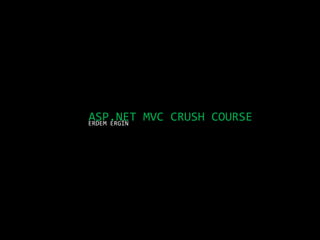
![MVC Pattern ŌĆō What is it?MVC - Acronym for Model/View/ControllerInvented by TrygveReenskaug[1973 - 1978]Originally used as an architectural pattern for GUIs.The first implementation of MVC was as part of Smalltalk-80 class library.](https://image.slidesharecdn.com/asp-netmvc-101216013952-phpapp02/85/Asp-net-mvc-2-320.jpg)
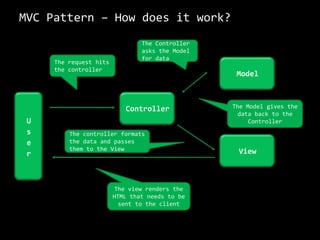
![MVC Pattern ŌĆō Who uses it?.NET has Spring.NET, MonoRailJava has Swing, Struts, Grails and othersPerl has Catalyst, Gantry, Jifty and othersPHP has Zend, Zoop, Agavi and othersPython has Django, Gluon, Pylon and othersRuby has Ruby on RailsApple has cocoa and cocoa touch for objective-c [Mac, iPhone]](https://image.slidesharecdn.com/asp-netmvc-101216013952-phpapp02/85/Asp-net-mvc-4-320.jpg)

![ASP.NET MVCItŌĆÖs not a replacement for asp.net webforms, itŌĆÖs a new option [flavor]](https://image.slidesharecdn.com/asp-netmvc-101216013952-phpapp02/85/Asp-net-mvc-6-320.jpg)

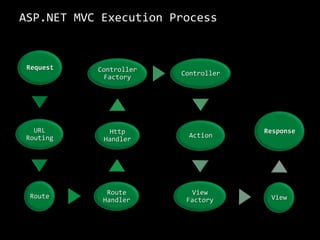
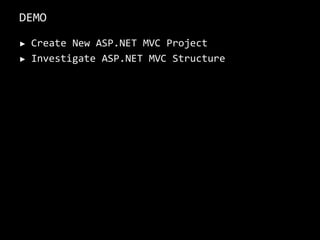
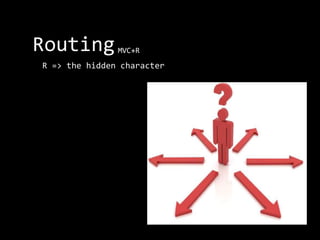
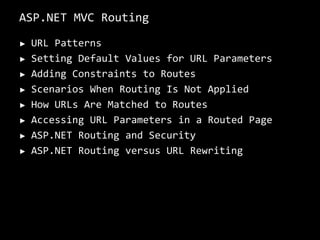
![All ASP.Net providers still work [Membership, Session, Caching, etc]](https://image.slidesharecdn.com/asp-netmvc-101216013952-phpapp02/85/Asp-net-mvc-12-320.jpg)
![Extensible and Pluggable [Support replacing any component]ASP.NET MVC Framework StructureASP.NET Abstractions(System.Web.Abstractions.dll)ASP.NET Routing(System.Web.Routing.dll)ASP.NET MVC(System.Web.Mvc.dll)](https://image.slidesharecdn.com/asp-netmvc-101216013952-phpapp02/85/Asp-net-mvc-13-320.jpg)


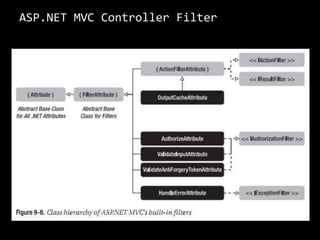

![Model [M]Validation](https://image.slidesharecdn.com/asp-netmvc-101216013952-phpapp02/85/Asp-net-mvc-18-320.jpg)
![Controller [C]Controlling the flow of application execution](https://image.slidesharecdn.com/asp-netmvc-101216013952-phpapp02/85/Asp-net-mvc-19-320.jpg)

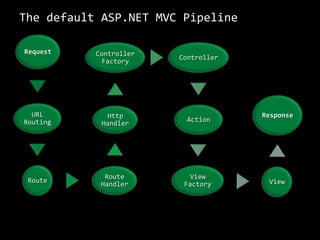
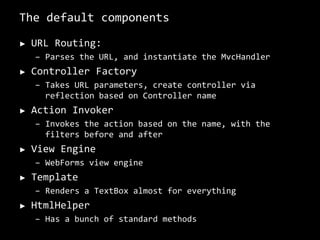
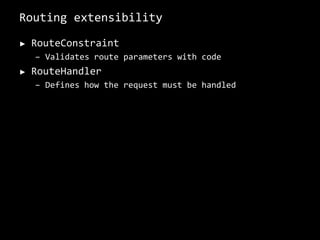
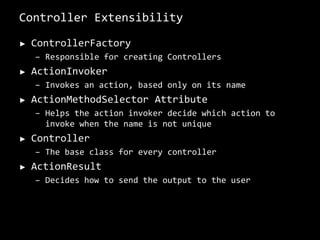
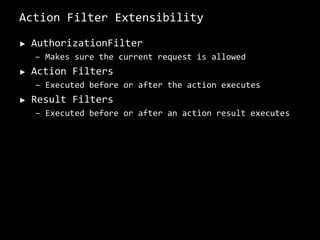
![ContentResult => text result [and wraps any non ActionResult return Type].](https://image.slidesharecdn.com/asp-netmvc-101216013952-phpapp02/85/Asp-net-mvc-26-320.jpg)
![FileContentResult => downloadable file [with the binary content].](https://image.slidesharecdn.com/asp-netmvc-101216013952-phpapp02/85/Asp-net-mvc-27-320.jpg)
![FilePathResult => downloadable file [with a path].](https://image.slidesharecdn.com/asp-netmvc-101216013952-phpapp02/85/Asp-net-mvc-28-320.jpg)
![FileStreamResult => a downloadable file [with a file stream]. Note: all public methods of a controller class consideredas action methods, if you donŌĆÖt want a public method to be an action, mark it with [NonAction()] attribute](https://image.slidesharecdn.com/asp-netmvc-101216013952-phpapp02/85/Asp-net-mvc-29-320.jpg)
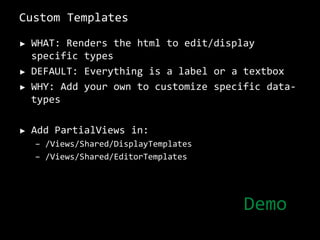
![View [V]](https://image.slidesharecdn.com/asp-netmvc-101216013952-phpapp02/85/Asp-net-mvc-31-320.jpg)
